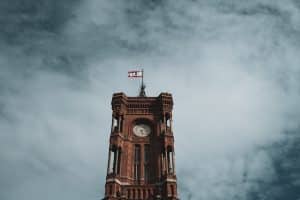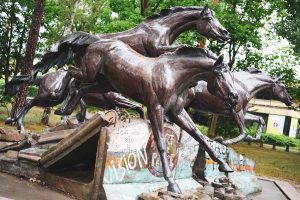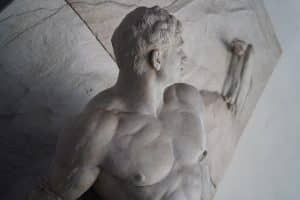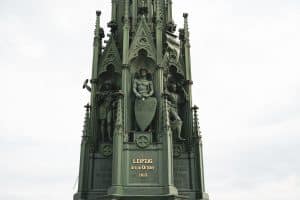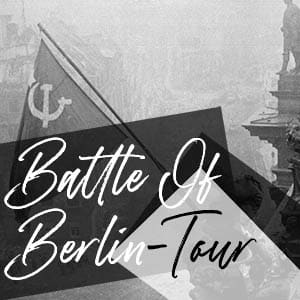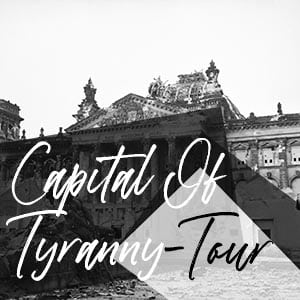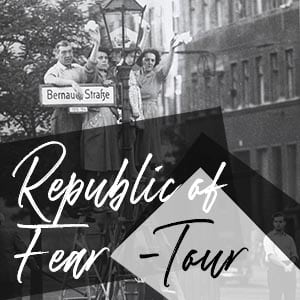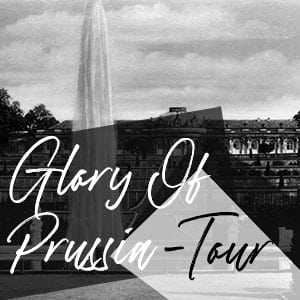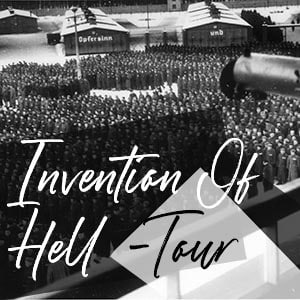Frequently absent from this distorted picture of Prussia are the many social, cultural, and political achievements that took place in this rump region before it became the largest and most dominant part of the German state.
From its time as a Duchy in the north of Poland (established and controlled by the Catholic military order of the Teutonic Knights after a holy crusade) to its diminished role in Hitler Germany as just one of the many state subordinate to centralised Nazi Party control – Prussia existed as a constant on the European map.
Feared for its military prowess, celebrated in the 1700s as a centre of Enlightenment, and able to contribute to the growth and success of Europe in many novel, and sometimes unusual, ways (such as popularising the potato!).
At its height, Prussia was one of the most influential powers in the world. Its ignominious end in 1947 – cut down with the stroke of a pen – would see the victorious Allies of the Second World War expunge Prussia completely, even if by this time it existed mostly in name alone.
To learn more about the history of Prussia – have a look at our Mythbusting Berlin article: What was Prussia? (COMING SOON)
Traces of the Iron Kingdom
What remains throughout Berlin – previously the capital of this mighty kingdom – are traces of its former glory and power. Memorials; and statues to its celebrated rulers, and the men and women who came to define its legacy.
This guide is first and foremost, an opportunity to discover more about the story of this extinguished state: the ‘Iron Kingdom’.
Its torch kept alight in the smallest of ways throughout the German capital, to be analysed, understood, and learned from.
What has been erased on paper – lives on in the history books and the traces of Prussia to be found on the streets of Berlin.
–
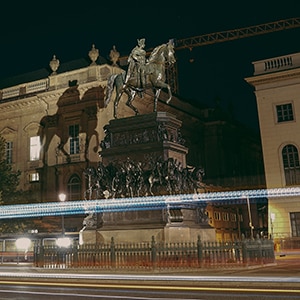
01 | Frederick the Great
As the first King of Prussia, Frederick II, developed a reputation as a feared military leader – but in private dreamt of becoming a respected philosopher. This equestrian statue of Old Fritz, sits on Unter den Linden in the Forum Fridericianum, the artistic and intellectual centre of enlightenment-era Prussia. Its presence on this street – where first introduced in 1851 – says a lot about the changing politics of memory in East Germany.
Having been encased in concrete to survive the Second World War, the statue was shuttled to various locations, until the Socialist state could reconcile the nuances of Prussian history and felt comfortable bringing Frederick back.
–
Address: Unter den Linden 9, 10117 Berlin
Website: None

02 | The Kreuzberg
The city district of Kreuzberg gets its name from a Prussian memorial – the National Monument for the Liberation Wars – constructed at the highest point in central Berlin. A cast-iron memorial designed to resemble the spire of a Gothic church, crowned with a cross – it commemorates the soldiers and civilians who gave their lives to liberate Prussia from Napoleon’s forces in what are sometimes also called the Wars of the Sixth/Seventh Coalition.
Had Napoleon stayed confined to the island of Elba in 1815 – and not been conclusively defeated at Waterloo the same year – it is possible that this famous district, and hill, may have aquired another name.
–
Address: Viktoriapark, 10965 Berlin
Website: None

03 | The Great Elector Statue
Now located in the courtyard of the Charlottenburg Palace, this bronze equestrian statue depicts Frederick William I – the Great Elector – considered the Grandfather of the Prussian state. Celebrated as one of the most important works of Baroque sculpture in the world – its beauty is cast in the shadow of the Great Elector’s role in enabling Prussia to become a major slave trading power.
In 1682, the Great Elector officially entered the Transatlantic Slave trade by founding the Brandenburg Africa Company, subsequently establishing the Brandenburg Gold Coast in nowadays Ghana to arrange the shipment of slaves and exotic animals.
–
Address: Spandauer Damm 10-22, 14059 Berlin
Website: Schloss Charlottenburg

04 | The Kaiser's Sarcophagus
The final resting place of German Emperor William I can be found hidden away in the tranquil gardens of the Charlottenburg Palace, where the man responsible for unifying Germany in 1871 is depicted in true Barbarossa-style slumber – his eyes resting while he clutches his sword and waits to be reawakened.
The mausoleum housing William was originally constructed for his mother, Prussian Queen Louise, who would be joined by her husband in 1840. Although neither of William I’s successors would be interned here – with the last German Emperor, William II, buried in the Netherlands after his abdication.
–
Address: Spandauer Damm 10-22, 14059 Berlin
Website: Schloss Charlottenburg
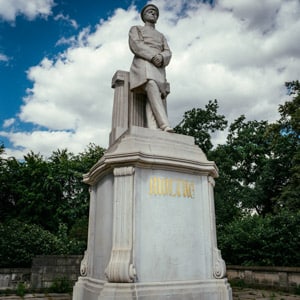
05 | Helmuth von Moltke
Widely acknowledged as one of the greatest military theorists to have ever lived, Prussian Field Marshal Helmuth von Moltke is said to pioneered the decentralised use of armies and subordinate officers in the field, in response to his oft-quoted protestation that “no plan survives contact with the enemy”.
Although he was popularly known in his own time as the ‘Great Quiet One’ – due to his preference for few words, Moltke now bears the distinction of being the only person born in the 18th century to still have a preserved audio reproduction of his voice, as he was recorded reciting Goethe and Shakespeare by one of Thomas Edison’s assistants, in 1889.
–
Address: Spreeweg 1, 10557 Berlin
Website: None
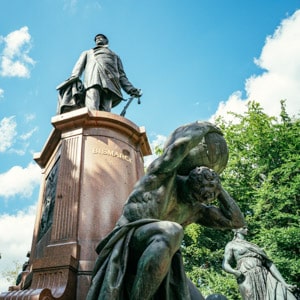
06 | Otto von Bismarck
The founding father of the German Empire – the George Washington of his time – no other person did so much to bring Germany together as one country as Otto von Bismarck – affectionately dubbed ‘The Iron Chancellor’. The German Empire’s first head of government can now be found next to the Siegessäule (Victory Column) in Berlin’s Tiergarten, near his compatriots Moltke and Roon.
Like the other statues, Bismarck previously stood in front of the Reichstag building before being moved here to make way for Adolf Hitler’s mammoth Germania project – with the streets around the Siegessäule redirected to form a big star (Grosse Stern).
–
Address: Spreeweg 1, 10557 Berlin
Website: None

07 | The Rudolf Virchow Statue
Considered the first person to develop a systematic method of autopsy to identify cause of death, Rudolf Virchow is often referred to as the father of modern pathology. Although an opponent of Charles Darwin and critical of modern Germ theory, Virchow contributed greatly to the city of Berlin – in particular by advising on the construction of the city’s sewage system.
Virchow considered politics “nothing else but medicine on a large scale” and was elected to the German parliament in 1880. He was also famously challenged to a duel by Otto von Bismarck, following a dispute over financial policies – to which he insisted he would only participate if they fought with sausages.
–
Address: Reinhardtstraße 40, 10117 Berlin
Website: None
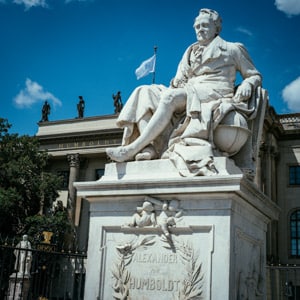
08 | Alexander von Humboldt
The most famous of the Humboldt brothers, Alexander was a highly regarded botanist, biologist, and explorer, responsible even for inspiring Charles Darwin to hop on the HMS Beagle and embark on his career as a scientist.
This lifesize resemblance now sits outside the university that bears his name – with the base of the statue bizarrely crediting him as the ‘second discoverer of Cuba’. The statue was in-fact a gift from the University of Havana – as Alexander von Humboldt is considered to be the first person to have extensively studied the animal and plant life of the region. Beyond the university there are plenty of things out there that also bear his name.
–
Address: Unter den Linden 6, 10117 Berlin
Website: Humboldt Universität
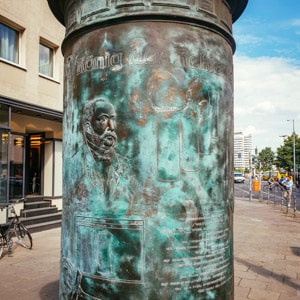
09 | The Litfass Column
A relic of the advertising monopoly that 19th century entrepreneur, Ernst Litfass, oversaw from 1855 – when the first 100 of these cylindrical advertising columns were introduced in Berlin. Presented as a solution to the cluttered mess of pamphlets and signs that previously littered the city streets, these ‘Litfass Columns’ were also an effective way of ensuring government censorship and regulating revolutionary political expression.
By banning flyposting elsewhere, and effectively making everything displayed on these columns subject to police review – the Prussian state established a system of controlling dissent with Litfass providing and profiting from the infrastructure.
–
Address: Reinhardtstraße 52, 10117 Berlin
Website: None

10 | The Neptune Fountain
The Roman god Neptune can now be found bathing in front of the Berlin City Hall (Rotes Rathaus) after being moved from his original spot in front of Portal II of the Berlin City Palace (Berliner Stadtschloss) – previously ground zero for Imperial Prussia; the point all Prussian milestones would lead back to.
Reference to the Fontana del Moro in Rome and the Latona Fountain at Versaille can clearly be seen in this bronze and granite ensemble designed by famous sculptor Reinhold Begas. With the four maidens representing the rivers that served to define the boundaries of Imperial Prussia – the Rhein, the Oder, the Elbe, and the Vistula (now in Poland).
–
Address: Rathausstraße 1, 10178 Berlin
Website: None

11 | The Ephraim Palais
This beautiful residence was constructed by Prussian Mint Master, Veitel Heine Ephraim – famous for debasing the Prussian currency to finance King Fredrick II’s wars. Due to its elegant rococo style, it became known as ‘the most beautiful corner of Berlin’. This heavily restored former residence, with its preserved original facade, houses a museum that often serves to showcase art and cultural exhibitions.
Amidst the surrounding area of the Nikolaiviertel that was severly damaged during the Second World War, only to be rebuilt by the East German government as a prefabricated Plattenbau form of medieval-Berlin Disneyland.
–
Address: Poststraße 16, 10178 Berlin
Website: The Ephraim Palais

12 | Martin Luther
Few people have had such a huge effect on Berlin as Martin Luther – whose form of Christianity would be hugely popular here. Responsible for translating both the Old and New Testament into German and effectively standardising the German language at the time, the Evangelical reformer can be found holding ‘the good book’ in full view of Berlin’s second oldest church – the Marienkirche, near Alexanderplatz.
Although the church dates back to the 14th century, Luther is not known to have managed to visit – however, in 1964, his namesake Martin Luther King Jr. did offer a sermon to a standing-room only audience of around 1,500 East German Christians.
–
Address: Karl-Liebknecht-Strasse 8, 10178 Berlin
Website: Marienkirche

13 | Friedrich Wilhelm von Steuben
As an official advisor to George Washington, Prussian Officer Friedrich Wilhelm von Steuben helped to reorganise and revolutionise the fighting tactics of the Continental Army during the War of Independence – many historians also consider von Steuben to have been one of early America’s most open LGBT figures.
Von Steuben had served as Prussian King Frederick the Great’s personal aide before joining the American revolutionary forces on the recommendation of Benjamin Franklin – rising to the rank of Inspector General. For his support he is now suitably honoured with this statue a short distance from the current US embassy – similar to the one to be found in Washington DC.
–
Address: Clayallee, 14195 Berlin
Website: None
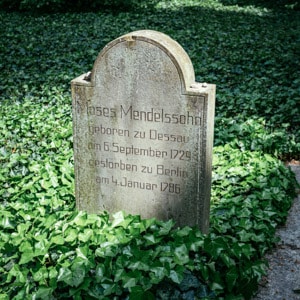
14 | Moses Mendelssohn's Grave
Undeniably one of the most important figures in the Jewish Englightenment movement (Haskalah), 18th century philosopher Moses Mendelssohn rose to prominence in Berlin with a work addressing the immortality of the soul – earning him the nickname ‘the German Socrates’. It was however his advocacy of integration, assimilation, and secularisation, that had a more lasting impact of Berlin’s Jewish inhabitants and secured Mendelssohn’s reputation as a towering figure of the Englightenment-era.
He was buried in the Grosse Hamburger cemetery in 1786, where a replica tombstone can now be found, standing tall and solitary amongst the ivy.
–
Address: Große Hamburger Strasse 25, 10115 Berlin
Website: The Jewish Cemetery
Explore these sites and more with a private guide in Berlin via Berlin Experiences.
Our Related Private Tours
Learn more about the Battle of Berlin and explore this urban battlefield with our Battle of Berlin tours.
Learn more about the history of Nazi Germany and life in Hitler’s Third Reich with our Capital Of Tyranny tours.
Learn more about the history of East German and life behind the Iron Curtain with our Republic Of Fear tours.
Learn more about the history of Prussia and the life of Frederick the Great with our Glory Of Prussia tours.
Learn more about SS ‘Protective Custoday’ on our Sachsenhausen Concentration Camp Memorial tours.


